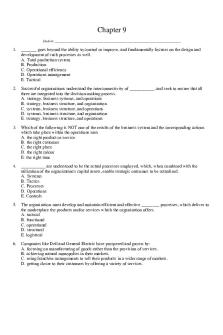Exam 2- chapter 9 photosynthesis PDF

| Title | Exam 2- chapter 9 photosynthesis |
|---|---|
| Author | Angela Awad |
| Course | General Biology I |
| Institution | Rutgers University |
| Pages | 2 |
| File Size | 49.1 KB |
| File Type | |
| Total Downloads | 28 |
| Total Views | 154 |
Summary
photosynthesis chapter bio 101...
Description
Chapter 9- Photosynthesis Photosynthesis Light energy chemical energy Light travels in packets of energy called photons Certain molecules can absorb certain wavelengths= pigments The light comes as white light Pigment- chlorophyll When light of a particular wavelength hits it, it forces the electron to move to a higher energy level o When the electron goes back to its original energy level it can emit heat or light (florescence) o Energy of the electron can be transferred to another molecule (resonance transfer) o The electron itself can be transferred Types of chlorophyll o Chlorophyll a- primary type in trying to convert the visible light into some form of chemical energy o Chlorophyll b- accessory pigment o Carotenoids- accessory pigments o Each of these have their own absorbency spectrum Chloroplast There is an outer membrane inter membrane system where there are thylakoids (membrane sack, or vesicle- has a membrane on the outside and the thylakoid lumen on the inside), stacks of thylakoid are granum 6CO2 + 12H2O C6H12O6 + 6O2 + 6H2O Photosynthesis is stages The products of one drive the second step 1. Light dependent- in thylakoids 12H2O + 2NADP + 18ADP + 18Pi We want to produce 6O2 + 12NADH +18ATP Pigments grouped as antenna complex- the pigments are located one right next to each other. Light hits a pigment and if it can’t do anything with the light it passes the light to the next pigment and it keeps going until it hits the reaction center pigment (specialized chlorophyll a molecule, specialized because of its location and the pigment molecules around it- it can now donate the high energy electron to a primary electron acceptor molecule) o Two types ( based on their absorption maximum) Photosystem II P680 light- light is indirectly involved, the electron splits the water molecule
electron going down chain to produce NADPH Non cyclic electron transport Photosystem I P700 light Cylic electron transport Produces ATP Generating ATP- based on chemiosmosis Through electron transport- between thylakoid and lumen Plasto chrinom sends the electron to the cytochrome o Then the electron are donated to plasto cyanine o Then taken to photosystem I Feradoxin sitting outside of photosystem I and it takes the electron and sends it to NADP feradoxin reductase o Then is donated to NADP + proton Increasing the number of protons in the lumen, in the stroma the protons are being used to reduce NADH Non cylic cycle is used to pump protons from the stroma into the lumen, and make a proton gradient o There is ATP synthase in order to allow protons through because the membrane won’t let them through 2. Carbon fixations- in stroma Take NADPH + 18ATP + 6CO2 C6H12O6 + 12NADP + ADP + Pi (inorganic phosphate) + 6H2O Fix carbon into RuBP (a 5 carbon compound), will react with CO2 and produce 2 3carbon compounds (PGA) RuBP carboxylase/ oxigonase- extrememly important enzyme o It catalyses a reaction In bundle sheath cell C3 plants work...
Similar Free PDFs

Exam 2- chapter 9 photosynthesis
- 2 Pages

Chapter 9 - Exam answers
- 67 Pages

Chapter 9 exam review
- 41 Pages

Chapter 7 Photosynthesis
- 17 Pages

Chapter 10- Photosynthesis
- 15 Pages

Chapter 5 Photosynthesis slides
- 28 Pages

Chapter 10: Photosynthesis
- 6 Pages

Chapter 8 Photosynthesis
- 21 Pages

Chapter 8 Review Photosynthesis
- 4 Pages

Photosynthesis study guide 2
- 2 Pages

Photosynthesis Lab Report 2
- 3 Pages

Chapter 9 practice exam questions
- 13 Pages
Popular Institutions
- Tinajero National High School - Annex
- Politeknik Caltex Riau
- Yokohama City University
- SGT University
- University of Al-Qadisiyah
- Divine Word College of Vigan
- Techniek College Rotterdam
- Universidade de Santiago
- Universiti Teknologi MARA Cawangan Johor Kampus Pasir Gudang
- Poltekkes Kemenkes Yogyakarta
- Baguio City National High School
- Colegio san marcos
- preparatoria uno
- Centro de Bachillerato Tecnológico Industrial y de Servicios No. 107
- Dalian Maritime University
- Quang Trung Secondary School
- Colegio Tecnológico en Informática
- Corporación Regional de Educación Superior
- Grupo CEDVA
- Dar Al Uloom University
- Centro de Estudios Preuniversitarios de la Universidad Nacional de Ingeniería
- 上智大学
- Aakash International School, Nuna Majara
- San Felipe Neri Catholic School
- Kang Chiao International School - New Taipei City
- Misamis Occidental National High School
- Institución Educativa Escuela Normal Juan Ladrilleros
- Kolehiyo ng Pantukan
- Batanes State College
- Instituto Continental
- Sekolah Menengah Kejuruan Kesehatan Kaltara (Tarakan)
- Colegio de La Inmaculada Concepcion - Cebu



